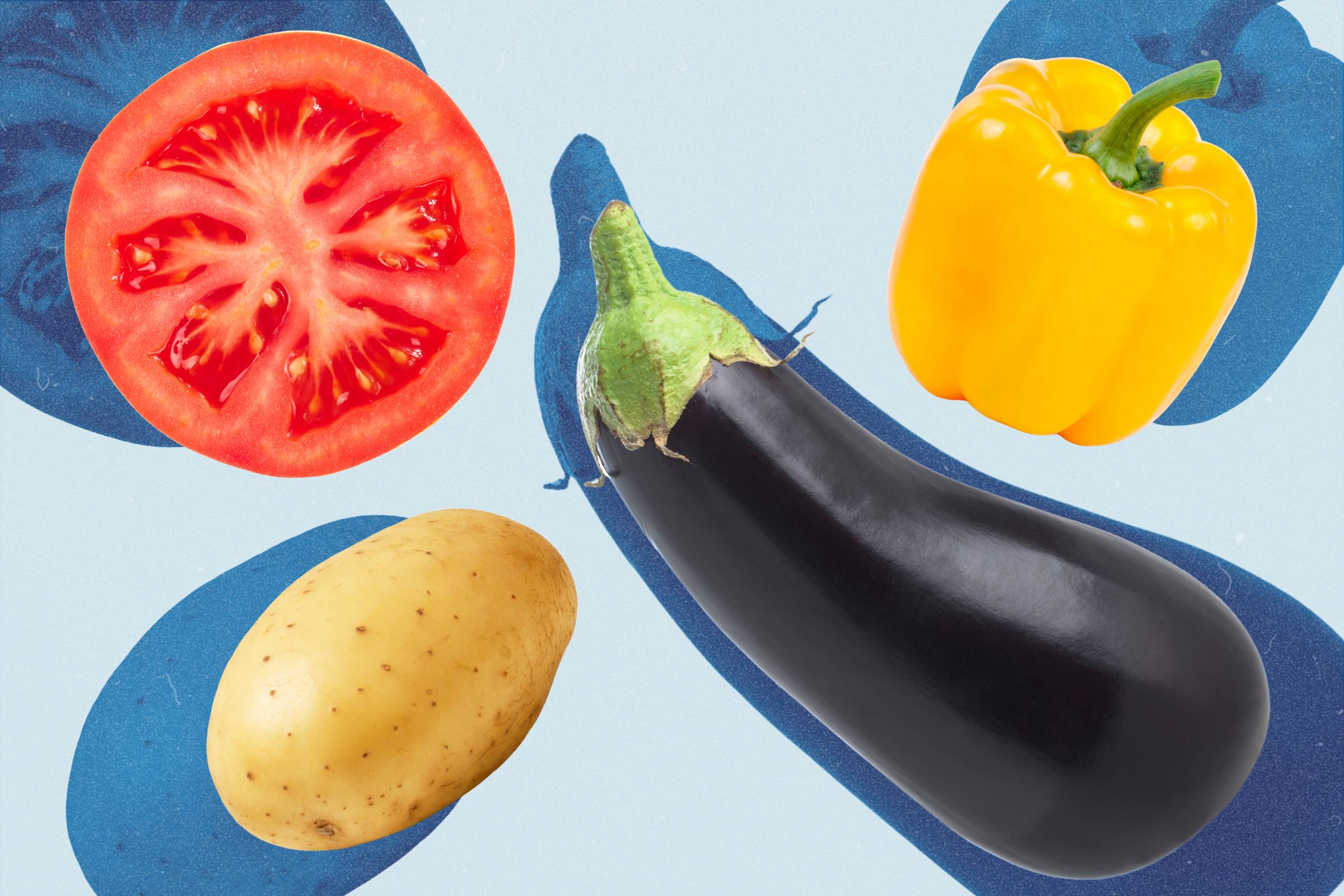Nightshade Vegetables Aren’t Actually Bad for You

If you’ve ever gone down the rabbit hole of health and wellness trends online, you’ve likely stumbled upon the so-called shadowy side of nightshades—vegetables that include tomatoes, potatoes, eggplants, and peppers. What’s made them suddenly newsworthy is that they’ve been singled out by self-proclaimed wellness experts and celebrity dieters as culprits behind a range of health issues, from arthritis to autoimmune disease flare-ups and indigestion.
While there’s little scientific evidence for these claims, some people report feeling better after cutting nightshades from their diets. So before you start side-eyeing your salad, eggplant parmesan, and baked potato, it’s worth taking a closer look.
[time-brightcove not-tgx=”true”]
Why have nightshades become so controversial (and where did that shady name come from, anyway)? Scientists, internal medicine doctors, and registered dietitians shed light on these unfairly maligned vegetables.
What are nightshade vegetables?
Nightshade vegetables come from the Solanaceae family of flowering plants, which are nutritional powerhouses, packed with vitamins (such as C and K), minerals (like potassium and magnesium), and fiber. Dietitians and doctors recommend them in abundance. In fact, they make up a few of the staples in one of the world’s healthiest eating plans, the Mediterranean Diet.
Here’s where the suspicion lies: These vegetables also contain alkaloids, which are natural chemicals produced by plants believed to deter predators. Consumed in very high concentrations, alkaloids, such as solanine in potatoes and eggplants, tomatine in tomatoes, or capsaicin in peppers can cause symptoms such as vomiting, diarrhea, and stomach pain.
This has led to debates about their effects in any dose. Joe Schwarcz, director of McGill University’s Office for Science and Society and author of A Grain of Salt: The Science and Pseudoscience of What We Eat, explains that while nightshades do contain alkaloids, the amount they typically contain are of no consequence. While potatoes, for example, which are eaten by a billion people worldwide, do contain solanine, the amounts are only in traces, he says. An average amount of solanine in a potato’s peel means a 200-pound person would have to eat 20 pounds of potatoes to experience a toxic level, according to the University of Nebraska.
Read More: Why Your Diet Needs More Fermented Pickles
However, there is a higher concentration of alkaloids in green, sprouted potatoes, which is why it’s important to store them in a cool dark place and toss any that have turned green and sprouted. During the 19th century Great Famine in Ireland, people ate a lot of potatoes that had been improperly stored for a long time, says Schwarcz. “But that doesn’t happen in North America. We don’t see potato poisoning or tomato poisoning or eggplant poisoning. We just don’t see it.”
These vegetables also contain lectins, notes Schwarcz, and while lectins can cause indigestion for some people, they’re innocuous for the vast majority.
The name “nightshades” comes in part from the infamous Belladonna plant, also known as the “deadly nightshade,” because it carries a highly toxic alkaloid called atropine, used historically both as a poison and medicine. This connection has stirred up myths about the toxicity of nightshade vegetables. “Just because the tomato and the potato are in the same botanical family as the Belladonna, it doesn’t mean that they are equally poisonous,” Schwarcz says.
The Tik-Tok effect: claims vs. science
On social media, you’ll find no shortage of videos and blogs vilifying nightshade vegetables, with titles ranging from “Foods to avoid if your pup suffers from arthritis,” to “These veggies could be worsening your eczema!” Most are the work of influencers and “self-appointed nutritional gurus,” notes Schwarcz. In his opinion, these creators run the gamut from “total incompetence…to physicians who have gone astray.” There are also many testimonials from people with autoimmune conditions such as lupus, psoriasis, and inflammatory bowel disease (IBD) who swear that they feel better when they cut out nightshades. While medical and nutrition experts suggest that some people likely would benefit from an elimination diet, blanket warnings against nightshades aren’t warranted.
Dr. Rebecca Kuang, an internal medicine resident at the University of Pittsburgh Medical Center, has been studying the connection between nightshades and gastrointestinal diseases. A literature review she co-authored last year showed that the natural chemicals in these vegetables might disrupt the gut barrier and possibly worsen symptoms for those with certain bowel diseases such as IBD. Many of the studies in the review were in mice, but if the findings hold true for humans, eating too many of these vegetables may worsen symptoms for those with certain bowel diseases such as IBD.
Read More: Why You Suddenly Have Allergies
Nightshades also contain potential allergens that might cause reactions similar to other food allergies, with cross-reactivity between foods in the nightshade family and others. Kuang’s research shows there is potential for nightshades to trigger mast cell activation, leading to inflammation and discomfort in the GI tract, similar to an allergic reaction.
However, research in this area is still new, with many studies relying on animals or involving variables that could affect the results. For example, Kuang is interested in how a nightshade vegetable’s preparation—such as fried potatoes with a high fat content—could affect some of the alkaloid levels. More basic science and human studies are needed, she says, to fully understand how nightshade foods may irritate the GI tract.
“I wouldn’t want the takeaway to be that everybody should be avoiding these foods,” she says, “but certain people might have sensitivities to them.”
What to do if you suspect you have an intolerance or allergy to nightshade vegetables
Navigating the complicated issues of food sensitivities, allergies, and intolerances can be tricky, particularly when it comes to nightshades. Diet and nutrition experts stress the importance of personalized approaches rather than broad exclusions. Lona Sandon, an associate professor in the department of clinical nutrition at the University of Texas Southwestern Medical Center, brings a personal perspective to her professional insights, having lived with rheumatoid arthritis, an autoimmune condition, for 30 years. “It’s been a long-standing folklore,” she says, adding that she’s tried eliminating nightshades herself, along with many other foods—to no avail. “There was not enough fish oil in the world, not enough fruits and vegetables in the world, that was going to fix what was happening with my immune system,” she says. Despite decades of debate, evidence about the nutritional impact of nightshades hasn’t increased much. “In fact,” Sandon says, “there’s more research to support that people should be including these foods in their diet when they have inflammatory conditions such as rheumatoid arthritis.”
If you suspect you may be sensitive to nightshades, Sandon says, don’t eat them for two weeks. Then slowly introduce them back into your diet. Allow about three days between each one, as reactions can be delayed. She recommends keeping a food and symptom diary to track potential sensitivities.
Read More: Magnesium Supplements Are a Buzzy New Sleep and Anxiety Aid. Do They Work?
Briana Butler, CEO of Gnaw Collective and a registered dietitian nutritionist specializing in nutrition coaching for athletes and women of color, explains that a registered dietitian can guide individuals through an elimination diet to identify food sensitivities and examine other potential factors like gut health. “There just is not enough research, in my opinion, to just cut [nightshades] out completely,” she says. “Those statements cannot possibly apply to everyone. It literally has to be a case-by-case basis and figuring out okay, what is actually going on?”
Butler points out that outright allergies to nightshades are rare, as they aren’t in the top nine most common allergens. Both Sandon and Butler caution against eliminating nightshades without substantial evidence of personal sensitivity. They encourage consultation with health care professionals for those experiencing adverse reactions, to ensure dietary changes are both necessary and beneficial.
The biggest takeaway? Our bodies react in unique ways to different foods. While some people might need to steer clear of certain foods, labeling them as toxic for everyone misrepresents the complexity of human biochemistry, says Schwarcz. “The main problem here, as with so many such issues, is taking a kernel of truth and then extrapolating it.” He cautions against the broad brush of fear-mongering on platforms like TikTok, where personal sensitivities are sometimes inflated into universal truths. Above all, most Americans don’t eat enough fruits and vegetables to begin with. Why limit your choices even further?
“Some people can’t tolerate beans or eggplants or whatever. You don’t eat them. But you don’t go on TikTok and tell everyone in the world that this is a poison,” he says. Schwarcz, for instance, is allergic to fish. But fish is healthy—and he’d never tell you to steer clear of it just because he does.
View original article
Contributor: Claire Sibonney

